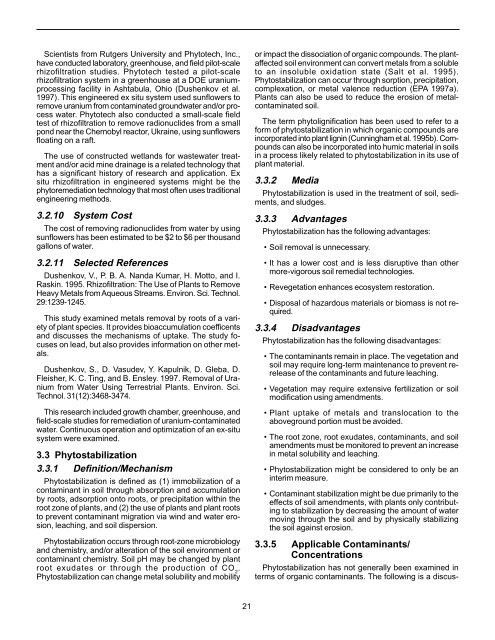Introduction to Phytoremediation - CLU-IN
Introduction to Phytoremediation - CLU-IN
Introduction to Phytoremediation - CLU-IN
Create successful ePaper yourself
Turn your PDF publications into a flip-book with our unique Google optimized e-Paper software.
Scientists from Rutgers University and Phy<strong>to</strong>tech, Inc.,<br />
have conducted labora<strong>to</strong>ry, greenhouse, and field pilot-scale<br />
rhizofiltration studies. Phy<strong>to</strong>tech tested a pilot-scale<br />
rhizofiltration system in a greenhouse at a DOE uraniumprocessing<br />
facility in Ashtabula, Ohio (Dushenkov et al.<br />
1997). This engineered ex situ system used sunflowers <strong>to</strong><br />
remove uranium from contaminated groundwater and/or process<br />
water. Phy<strong>to</strong>tech also conducted a small-scale field<br />
test of rhizofiltration <strong>to</strong> remove radionuclides from a small<br />
pond near the Chernobyl reac<strong>to</strong>r, Ukraine, using sunflowers<br />
floating on a raft.<br />
The use of constructed wetlands for wastewater treatment<br />
and/or acid mine drainage is a related technology that<br />
has a significant his<strong>to</strong>ry of research and application. Ex<br />
situ rhizofiltration in engineered systems might be the<br />
phy<strong>to</strong>remediation technology that most often uses traditional<br />
engineering methods.<br />
3.2.10 System Cost<br />
The cost of removing radionuclides from water by using<br />
sunflowers has been estimated <strong>to</strong> be $2 <strong>to</strong> $6 per thousand<br />
gallons of water.<br />
3.2.11 Selected References<br />
Dushenkov, V., P. B. A. Nanda Kumar, H. Mot<strong>to</strong>, and I.<br />
Raskin. 1995. Rhizofiltration: The Use of Plants <strong>to</strong> Remove<br />
Heavy Metals from Aqueous Streams. Environ. Sci. Technol.<br />
29:1239-1245.<br />
This study examined metals removal by roots of a variety<br />
of plant species. It provides bioaccumulation coefficents<br />
and discusses the mechanisms of uptake. The study focuses<br />
on lead, but also provides information on other metals.<br />
Dushenkov, S., D. Vasudev, Y. Kapulnik, D. Gleba, D.<br />
Fleisher, K. C. Ting, and B. Ensley. 1997. Removal of Uranium<br />
from Water Using Terrestrial Plants. Environ. Sci.<br />
Technol. 31(12):3468-3474.<br />
This research included growth chamber, greenhouse, and<br />
field-scale studies for remediation of uranium-contaminated<br />
water. Continuous operation and optimization of an ex-situ<br />
system were examined.<br />
3.3 Phy<strong>to</strong>stabilization<br />
3.3.1 Definition/Mechanism<br />
Phy<strong>to</strong>stabilization is defined as (1) immobilization of a<br />
contaminant in soil through absorption and accumulation<br />
by roots, adsorption on<strong>to</strong> roots, or precipitation within the<br />
root zone of plants, and (2) the use of plants and plant roots<br />
<strong>to</strong> prevent contaminant migration via wind and water erosion,<br />
leaching, and soil dispersion.<br />
Phy<strong>to</strong>stabilization occurs through root-zone microbiology<br />
and chemistry, and/or alteration of the soil environment or<br />
contaminant chemistry. Soil pH may be changed by plant<br />
root exudates or through the production of CO 2 .<br />
Phy<strong>to</strong>stabilization can change metal solubility and mobility<br />
21<br />
or impact the dissociation of organic compounds. The plantaffected<br />
soil environment can convert metals from a soluble<br />
<strong>to</strong> an insoluble oxidation state (Salt et al. 1995).<br />
Phy<strong>to</strong>stabilization can occur through sorption, precipitation,<br />
complexation, or metal valence reduction (EPA 1997a).<br />
Plants can also be used <strong>to</strong> reduce the erosion of metalcontaminated<br />
soil.<br />
The term phy<strong>to</strong>lignification has been used <strong>to</strong> refer <strong>to</strong> a<br />
form of phy<strong>to</strong>stabilization in which organic compounds are<br />
incorporated in<strong>to</strong> plant lignin (Cunningham et al. 1995b). Compounds<br />
can also be incorporated in<strong>to</strong> humic material in soils<br />
in a process likely related <strong>to</strong> phy<strong>to</strong>stabilization in its use of<br />
plant material.<br />
3.3.2 Media<br />
Phy<strong>to</strong>stabilization is used in the treatment of soil, sediments,<br />
and sludges.<br />
3.3.3 Advantages<br />
Phy<strong>to</strong>stabilization has the following advantages:<br />
• Soil removal is unnecessary.<br />
• It has a lower cost and is less disruptive than other<br />
more-vigorous soil remedial technologies.<br />
• Revegetation enhances ecosystem res<strong>to</strong>ration.<br />
• Disposal of hazardous materials or biomass is not required.<br />
3.3.4 Disadvantages<br />
Phy<strong>to</strong>stabilization has the following disadvantages:<br />
• The contaminants remain in place. The vegetation and<br />
soil may require long-term maintenance <strong>to</strong> prevent rerelease<br />
of the contaminants and future leaching.<br />
• Vegetation may require extensive fertilization or soil<br />
modification using amendments.<br />
• Plant uptake of metals and translocation <strong>to</strong> the<br />
aboveground portion must be avoided.<br />
• The root zone, root exudates, contaminants, and soil<br />
amendments must be moni<strong>to</strong>red <strong>to</strong> prevent an increase<br />
in metal solubility and leaching.<br />
• Phy<strong>to</strong>stabilization might be considered <strong>to</strong> only be an<br />
interim measure.<br />
• Contaminant stabilization might be due primarily <strong>to</strong> the<br />
effects of soil amendments, with plants only contributing<br />
<strong>to</strong> stabilization by decreasing the amount of water<br />
moving through the soil and by physically stabilizing<br />
the soil against erosion.<br />
3.3.5 Applicable Contaminants/<br />
Concentrations<br />
Phy<strong>to</strong>stabilization has not generally been examined in<br />
terms of organic contaminants. The following is a discus-
















